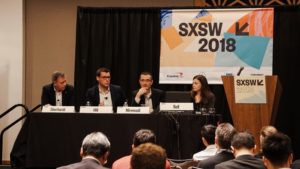
Speakers: Host: Karissa Bell from Mashable, Wilfried Eberhardt form KUKA, Jan Hill adidas AG and Mehdi Miremadi from McKinsey & Company
Over the course of time, people have always been curious or weary about the technology process in smart robots. While the interested in new technology and the possibility of robots integrating into peoples everyday lives, there is a lot of question about where we are now with that technology. In the panel “We Want It Now: The Future of AI is in Your Hands” the panelist from various technology backgrounds speaks to the advances in AI technology and where the future is headed for humans and AI technology.
In this session, they addressed what is special about the changes in AI technology? Mehdi Miremadi mentions that we have had robots since the 70s, but now they are smart; they are mobile, they are connected to the cloud and are more intelligent. There new software in AI and it is evolving, which all panelist agree will benefit the future for human and robot technology.
Another aspect of the future of AI that was discussed was the need to be flexibility and sensibility with the software. This will, in turn, make bigger advances in the robot’s technology. For example, the panelist comment that the consumer is always looking for the newest product and the new advances, especially the millennial age group. They are more aware and acceptable to adapting to AI.
The panelist also answers back to the critique that AI can be good at task but not creative task. Jane Hill addresses the questions by saying that innovation and changing the models, is crucial. This includes talking to automation companies and designing on a higher level of creation. Digitizing the process will also help the time and advances in AI becoming between at creative task. Hill then compares that before designing might have been created with paper and pencil, now we can design through machine and have more data to foresee the goals and making AI better.
The next topic discussed was the perception that AI machines will take jobs away for humans. Mehdi tells stats that about 5% of jobs can be fully automated. While this percent might change through the advances in technology the occupations, that require more creativity and emotional aspects will need a human mind. While advance to make AIs be creative and smart, there is not there yet but the occupation the can be filled with AI. This might not mean that there are job loss, it might but I will change the job landscape between humans and AI’s.
Karissa Bell also mentions that AI’s are not against humans they are not competition, they are to help and make things easier. Machines don’t get tired they can do continuous labor while humans can think and add the creativity that AI’s cannot. This is power when Humans and Machines can come together. Right now everything is done manually, and now people are bringing robots into their houses because the consumer is asking for that manual help.
The last discussion was how close are we to seeing and touching a robot every day? Karissa says “we are very close, robots will be like a smartphone hopefully, affordable. So, it will be interesting to see what the future will look like when that comes.” While AI and robot technology is progressively advancing and will be a part of the near future Mehdi does say these products to hit the market will need some time. However, the future for AI is making advances and yes, robots are in the future.
Featured image: Annabel Fidler
